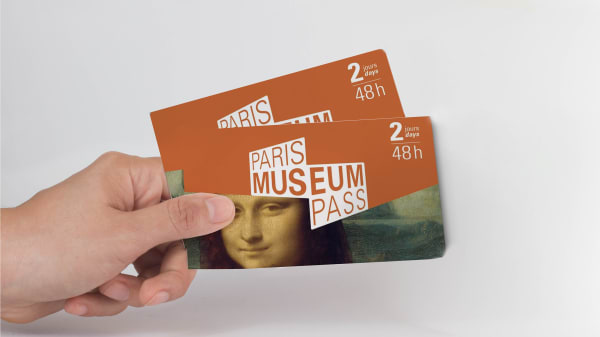Moving Around Paris on a Budget - Money Saving Tips
All the tips you need if you’re on a tight budget for your holiday to Paris. Here you can find out how to save up on travel and everyday expenses, accommodation, and transport
Moving Around Paris on a Budget - Money Saving Tips
All the tips you need if you’re on a tight budget for your holiday to Paris. Here you can find out how to save up on travel and everyday expenses, accommodation, and transport
How can I visit Paris on a dime? Economic ways to travel to Paris
There are many ways you can get to Paris without spending too much money. Normally, the earlier you book, the cheaper your trip will be, so we recommend you book your plane, train, or bus ride as soon as you can.
In terms of the cheapest way to get here, that is usually the bus. While the journey can be long, the fares are a lot cheaper than all other means of transport. We particularly recommend getting a bus if you find yourself in a neighbouring country, like Belgium, Luxembourg, Germany, Switzerland, and even Italy and Spain. Another plus you should consider about buses is that they are a lot more environmentally friendly than planes. Some of the most popular European bus companies that will get you to Paris at a low cost are Eurolines , Flixbus , Omio , and Alsa .
If you prefer something quicker, there are lots of trains that travel to the French capital every day. London, Brussels, Luxembourg, Barcelona, and Milan all have direct high-speed train lines connecting them to Paris.
As for planes, the best advice we can give you is to check all airports. Even though Charles de Gaulle is the biggest and main one, Paris has two other airports, Orly and Beauvais. The latter in particular tends to have lots of convenient offers with low-cost airlines.
And now, a bit of advice that is valid no matter the means of transport you choose: travel during the low season. This will save you quite a bit in accommodation and travel costs. Time periods and seasons to avoid if you want to save money are Christmas time, the summer holidays, and Easter week.
What are the best money-saving travel hacks when in Paris?
Even though Paris is an overall expensive city, you don’t have to break the bank for a holiday here, as long as you are careful with your expenses and use a few tricks.
First of all, you should learn all about special discounts and check if they apply to you. This could be due to the dates you’re travelling, your age, or any special initiatives by the city’s administration. The following are always valid.
- On public transport: Children under the age of 3 travel for free on Paris’ public transport. Children aged 4-9 are entitled to discounts.
- At the major attractions: EU residents under 26 and minors (under 18) of any nationality can have free access to national museums and permanent collections in Paris. Retirees, people with disabilities, students, and large families often have discounts at museums and monuments. Furthermore, museums in Paris are free for everyone on the first Sunday of each month.
Another easy way to save money during your stay is to book your accommodation early. If you are booking during the high seasons (summer, Christmas time, Easter holidays), this is even more important. Even if Paris is a large city, the most convenient hotels and apartments get booked quickly, so you need to be prepared. We suggest you find and book your hotel or apartment in Paris immediately, which you can do here.
Once you’re in the city, you should also consider getting discount cards. There are many options, the most well-known and used ones being the Paris Museum Pass, the Paris Pass, and the Paris Passlib’. With these cards, you can get free entries to Paris’ attractions and free tours around the city. You can see a comparison of the three options and choose the one that fits you best in our dedicated article (Paris Museum Pass vs Paris Pass vs Paris Passlib).
Lastly, you should always try to make the most of the offers you get. If, for example, you decide to get a hop-on hop-off bus tour (which is a great way to familiarise yourself with the city and learn about the sights), use the bus as your sole means of transport for the day. Don’t waste money on a Métro/RER pass for the day, just use the hop-on hop-off bus to move between different areas. These buses run non-stop for the entire day and cover all the main areas in the city centre.
Of course, there are lots of other ways you can minimise your expenses while in Paris (like getting a baguette sandwich at a bakery rather than sitting down at a restaurant for lunch or ordering tap water instead of bottled), but these were the most impactful.
How much should I bring to Paris for a week-long trip?
Of course, your overall expenses will vary a lot depending on the type of holiday you intend to have and the kinds of activities you have planned. In any case, your daily budget for food, the average amount of sightseeing, tours, and transport, should be between €50.00 and €80.00. This does not include accommodation.
For your hotel, apartment, or hostel, you will be spending anywhere between €50.00 a day to €150.00. Remember that, if you book in advance, the cost of accommodation will considerably decrease - in that case, you can expect a range between €30.00 and €130.00.
If you want more detailed information about average expenses in Paris, you can check out our dedicated article.
How should I plan a two-week trip in Paris on a budget?
Normally, a longer trip will decrease your daily expenses, since you won’t be in such a rush to pack your days full of activities. Therefore, the most effective way to be cost-effective is to plan your holiday carefully.
First of all, make sure you book your accommodation well in advance. Lots of hotels, apartments and even hostels offer extra discounts for early bookings and stays longer than a week. However, if you book too late, you might not be able to stay at the same place for the entire duration of your holiday, therefore you won’t get the discount. In short, book your stay as soon as you can.
Secondly, we recommend you get the weekly Navigo transport card. The pass only costs €22.80 and it allows transport across the entire Parisian network in all zones, Monday to Sunday.
Of course, all other advice valid for budgeting while in Paris (like getting discount cards and tourist passes) is still valid for a two-week stay in the city.
What’s the cheapest way to get around on the Paris Métro/RER?
This depends on what your habits are in regard to public transport and when you are visiting the city. There are three main transport passes in Paris, and all three are valid for Métro, RER trains, urban buses, tramways, and the Montmartre funicular.
The tickets are the T+ ticket, the Passe Navigo and the Paris Visite. The cheapest of the three is the T+ 10 carnet, for €14.90. This is basically a booklet of 10 single tickets valid for Zone 1 (the city centre). However, the cheapest option per journey will be the Passe Navigo. For €22.80, with the Navigo, you can travel unlimitedly in all zones (1-5) for an entire week (Monday to Sunday).
Unfortunately, you can only buy the Navigo from Monday to Thursday, so if you arrive on Friday and are only in the city until Sunday or Monday, you won’t be able to purchase it. In that case, you can rely on the T+ 10 carnet or on the Paris Visite (a multi-day pass for 1, 2, 3, or 5 days).
If you’d like to see a full comparison of the three ticket options, you can have a look at our dedicated article.
Which Paris Métro tickets should I buy for a week-long trip?
If your Paris trip occupies a whole calendar week (from Monday to Sunday), you should get the Passe Navigo. This is an unlimited travel pass valid for all Paris transport zones (1 to 5), all means of public transport, for the entire duration of the week. The only drawback is that the Navigo can only be purchased from Monday to Thursday, and it is only valid for the current calendar week.
If you arrive on a Saturday night or Sunday, we recommend you purchase a Navigo for the following week and get by with single tickets until Monday morning. If instead, you are travelling between weeks (for example arriving on a Friday and leaving on a Thursday), you might want to purchase a T+ 10 carnet (a pack of 10 single tickets valid for central Paris only) or a Paris Visite (a multi-day pass).
The choice between the two depends on how often you plan on using public transport and where. If you mainly want to move in central Paris (arrondissements 1 to 20) and don’t plan on making more than two or three journeys per day, you can just get two T+ 10 carnets to last you the entire week (this will cost you €29.80).
If you plan on using public transport more than three times per day every day (in central Paris), you should get a 5-day Paris Visite for zones 1-3 (€38.35). And finally, only if you constantly need to travel between the outskirts and the city centre, you should get a Paris Visite for 5 days for zones 1-5 (€65.80). Of course, you might still need to add a couple of journeys, since the maximum time validity for a Paris Visite is 5 days.
For a detailed comparison of the three passes, you can have a look at our dedicated article.
Should I buy a Paris Pass?
Only if you like walking tours, guided activities, and bus tours. Otherwise, get a Paris Museum Pass.
A Paris Pass is a multi-day tourist pass that gives users free tours and activities around the city, as well as free access to some of Paris’ main attractions. The 4-day and the 6-day Paris Pass also include a Paris Museum Pass (of the same duration as the respective Paris Pass). Following is the cost of each Paris Pass option.
| Duration |
|---|
| Price |
| Duration | 2 days | 3 days | 4 days | 6 days |
|---|---|---|---|---|
| Price | €89.00 | €119.00 | €199.00 | €229.00 |
In our opinion, considering the cost and the activities included, the Paris Pass is a great choice for those who enjoy walking tours, guided activities, and bus tours. For visitors mainly interested in sightseeing and museum visits, the Paris Museum Pass is a much better option: it only includes museums, monuments, and sights, but the cost is considerably lower. You can find a summary of the prices below.
| Duration |
|---|
| Price |
| Duration | 2 days | 4 days | 6 days |
|---|---|---|---|
| Price | €52.00 | €66.00 | €78.00 |
What are some tips and tricks for the Paris Métro & RER?
Parisian public transport is pretty straightforward, so the main way to save money is to choose the right kind of ticket for your stay. However, there are a couple of things to keep in mind if you want to make the most of whatever ticket you are using.
- Tickets and passes in Paris are completely integrated, meaning they are valid across the entire network and they work for transfers between different transports too. This is particularly important if you are using T+ tickets (either singles or the T+ 10 carnet). The following table illustrates the time validity of each ride and the transfers you can make (without it counting as a different journey).
| First validation |
|---|
| Métro |
| Bus |
| RER |
| Tram |
| First validation | Validity | Possible transfers |
|---|---|---|
| Métro | 2 hours | Other Métro linesMétro-RER |
| Bus | 90 mins | Other bus linesBus/trams |
| RER | 2 hours | Other RER linesRER-Métro |
| Tram | 90 mins | Other tram linesTram-bus |
- If you are using a Paris Visite, remember that the pass gives you discounts on selected tourist sights, so always ask at the front desk.
Furthermore, independently of the type of pass you have, remember that young children always have discounts on Parisian transport.
- Children under the age of 3 travel for free on Paris’ public transport.
- Children aged 4-9 are normally entitled to discounts, always ask at the desk before buying your tickets.
Do the Paris Métro passes include RER?
Normally yes, since the transport network in Paris is completely integrated. This means that T+ tickets, Passe Navigo and Paris Visite are valid for the Métro and RER trains (as well as the tram, urban buses, and Montmartre funicular).
However, you need to consider the zone validity of your ticket or pass. The Paris Métro is only present in Zone 1 (roughly corresponding to arrondissements 1 to 20). The RER system, instead, covers zones 1 to 5. This means that if you have a ticket valid only for Zone 1 (like the T+ tickets) or Zone 1-3 (like certain kinds of Paris Visite), you won’t be able to use the RER past those zones.
If you have a Passe Navigo or a Paris Visite for zones 1-5, you don’t have to worry, those are valid for all zones.
What places can I visit with a Paris Zone 1-3 travel card?
If your travel pass in Paris is valid for public transport zones 1 to 3, that includes the entire central Paris area (arrondissements 1 through 20) and some of the suburbs surrounding it. Here is a list of attractions you will find in Paris Zones 1-3.
- Eiffel Tower
- Notre-Dame
- Arc du Triomphe
- Panthéon
- Louvre Museum
- Musée d’Orsay
- Conciergerie
- Musée de Cluny
- Centre Pompidou
- Musée de Rodin
- Musée du Quai Branly
- Basilique du Sacré-Coeur
- Sainte-Chapelle
- Les Invalides complex
- Musée de l’Orangerie
- Père-Lachaise Cemetery
- Musée des Arts Décoratifs
- Chapelle Expiatoire
- Cité des Sciences et de l’Industrie
- Musée Guimet
- Musée Nissim de Camondo
- Musée de Picasso-Paris
- Île de la Cité
- Cité des Sciences
- Château de Vincennes
- Cinémathèque Française
- Montparnasse Tower
- Grévin Wax Museum
- Dali Paris
- Grande Arche de La Defense
- Musée d’Art et d’Histoire du Judaisme
- Musée de l’Institut du Monde Arabe
- Musée de la Marine
- Musée de l’Histoire de l’Immigration
- Palais de la Découverte
- Musée des Arts et Métiers
- Cité de l’Architecture et du Patrimoine
- Musée Gustave Moreau
- Musée Jean-Jacques Henner
- Musée Eugéne-Delacroix
However, there are a few well-known attractions that are located further out in Paris. The Palace of Versailles (in Zone 4), Disneyland Park, and the Walt Disney Studios (both in Zone 5) are the most famous. This means that, if you have a travel pass valid for zones 1 to 3 (or less), you will need to get another ticket or book a private transfer to reach these attractions.





















